Sorry.
“Concept” cars are for display only, like Fonzie’s jacket at The Smithsonian, and are a company’s way of showing what they’re capable of while giving us a glimpse of a possible automotive future.
Since I work for the press, I got a sneak peek at this year’s auto show, which featured about two dozen new concept cars. Included here is information on 14 of them.
| Chrysler Crossfire – The Crossfire features integrated trunk space for two helmets, indicating that speed drives this concept. The sculpted hood focuses attention on the new grille and winged badge. And the curvature of the back-end, along with its unique shape, makes the car look aerodynamic enough to win the 24 Hours at LeMans race while going in reverse. And if you want to know your speed, lap time and even g-forces, then you’ll love the Electronic Vehicle Information Center (EVIC), located on the passenger side console. g-whiz! |
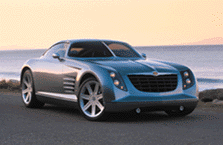 |
|
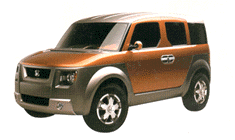 |
Honda Model X – Judging from the coincidentally similar looks of the Isuzu GBX, GMC Terracross and the Honda Model X, is this the look SUVs are evolving into? Conceived at the inaugural X games in 1998, the Model X is targeted toward college-age guys who need a functional vehicle to carry all their stuff on road trips. As a former college-age guy who had no possessions besides beer and the occasional textbook, I’m surprised to see how big the Model X is. The “open-wide” side doors allow for easier loading and give the vehicle an open-air feel. Also important for road trips: a flip-up navigation screen that arises from the dashboard. | |
| Dodge Super 8 HEMI – Called the “all-American” return of the sedan, the Super8 HEMI has the family in mind. The HEMI pays particular attention to design, space and comfort. Inside, it pays homage to the 1950s (when the term “nuclear family” was coined), with brushed and painted aluminum gauges and trim. The back seats appear to be floating in air, thanks to an absence of a B-pillar. Instead, the bench-seat is supported on a rail system. The Infotronic voice-recognition system allows the driver to control audio, climate and phone systems without taking his hands off the wheel. | 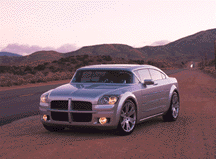 |
|
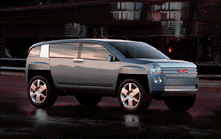 |
GMC Terracross – The Terracross takes the rugged theme of SUVs and shows how sleek a highly functional vehicle can be. And if the sharp lines aren’t enough to catch your attention, keep in mind the Terracross can be converted into a pickup or a five-seat convertible. And don’t worry about spraining an ankle trying to climb in because the floor in the Terracross is lower than traditional SUVs. This lower floor also makes it easier to load and unload cargo, even if for most of us, our cargo never extends beyond groceries or golf clubs. | |
| VW Microbus – Usually, a car with the prefix “micro” in its name shouldn’t be five meters long, but when that prefix is followed by the word “bus,” it begins to make sense. While it’s not tie-dyed, the Microbus does hark back to the VW vans of lore, when they sat eight comfortably, but 13 in general. The front end features flat double-xenon headlights, which is a stylistic counter to the rounded headlights of the old VW buses. Inside, the middle center seats can be turned 180 degrees, giving those passengers the option to watch television on the 7-inch screen in front or on the one in the back. | 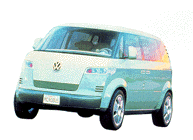 |
|
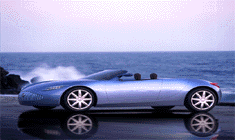 |
Buick Bengal – Tiger Woods can be seen on Buick ads, but the Bengal may be the first Buick that caters to his generation. It’s a roadster that seats four – or fold the backseat down and you’ve got a two-seater. Its V6 engine packs 250 horsepower, enough get-up-and-go to outrun one of Woods’ 300-yard drives. Thanks to Quiet Servant, a voice-activated control system that enables drivers to call up gauges on a head-up display on demand, the dashboard looks simple, uncluttered and elegant. The voice-activated system keeps the knobs and gauges off the dash. | |
| Jeep Willys – This concept may give you the willies, since it uses colors from the back of the crayon box. (It’s dashboard is an “under-the-blacklight green.”) The Willys’ injection-molded plastic body saves up to 50 percent in weight and allows designers to create shapes they couldn’t with stamped metal. The vehicle pays homage to the Jeeps of old while showcasing design and technology of today and beyond. And Willys’ Sirius Satellite Radio allows you to get 100 news, sports and entertainment channels, 50 of which are commercial-free. | 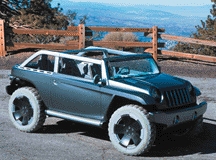 |
|
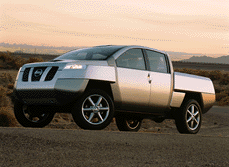 |
Nissan Alpha T – This concept follows up last spring’s announcement that Nissan will produce a full-size V8-powered truck in the next few years. The Alpha T has a strong, industrial feel and drew inspiration from high-end power tools and other mechanical designs. The concept features a massive front grille, bumper and headlights, a scooped hood, four-door butterfly open doors for easy access and a unique glass panel roof treatment with personalized opening sections. Inside, the rear compartment has a fold-down table (poker, anyone?) and its own climate-control system. | |
| BMW X Coupe – X marks the spot with this year’s concept vehicles, as it seems everyone has an X somewhere in a concept’s moniker. BMW is no different. The X Coupe is an attempt to combine sportiness with the drivability of an SUV. In other words, it’s trying to find harmony in incompatibility. Most striking on the X is the rear hatch that opens backward along a line that runs down the right passenger side. This makes loading and unloading of cargo and backseat passengers easier. The instrument console revolves around the driver, enabling only him to see the readouts, and the brakelights get brighter the harder the car decelerates. | 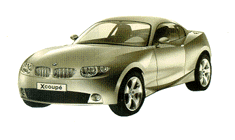 |
|
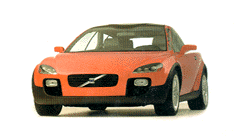 |
Volvo SCC – The Volvo Safety Concept Car (SCC) has a boatload of safety features. Rearward-facing cameras built into the door can show the driver what’s in the blind spot. Headlight beams adapt to the road, meaning the lights direct their beam in the direction the car is turning at a crossroad or a curve. The brake lights flash on harder stops to alert following vehicles. And if you hate adjusting the mirrors or seats when you get behind the wheel, then get a load of this: A sensor identifies the location of the driver’s eye and automatically adjusts so the driver has the best possible field of vision. | |
| Cadillac Vizon – Is it a station wagon or an SUV? It’s a combination of both. The Vizon is Cadillac’s way of saying the company is ready to re-invent itself on the verge of its centennial in 2002. If the Jetsons needed a sports-utility wagon, this could be it. They’d look sharp riding behind the “bulldog” stance of the Vizon. The egg-crate grille extends nearly across the whole front end, and look at the grille just in front of the front passenger doors. When the car is at rest, the grille remains closed, giving the vehicle a clean look. But when the car’s in motion, it opens to draw out heat and cool the engine. | 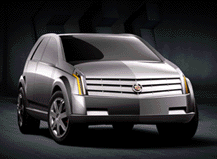 |
|
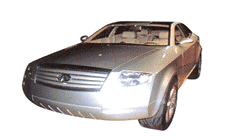 |
Infiniti FX45 – Because Infiniti contends that most consumers rarely try to push their off-road vehicles to the limit, the FX45 is a sports wagon designed to be all-weather, not all-terrain. Despite its label as a sports wagon, the FX45 takes many of its cues from the BMW 7 series, giving the concept a more sedan-like appearance. Other vital items include a glass roof with automatic shade adjustment, a split tailgate with a slide-out floor and a multi-zone climate control, for when you want to stay warm but want the beer in the seat next to you to stay cold. | |
| Isuzu GBX – Just once, wouldn’t it be great if your vehicle had tool storage and work shelves? The makers of the GBX agree. But the GBX has more. With a power sliding canvas cargo-area roof, power-articulated side and rear steps, and cantilevered seats designed for underseat storage, the GBX is a great tool for hauling gear and people. The interior features rinsable, water-proof floor and seat materials, so you can drive in a monsoon and still leave the windows down. And detachable flashlight reading lamps enable you to better see the map at night when you’re lost. | 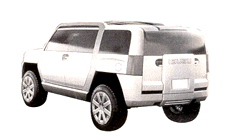 |
|
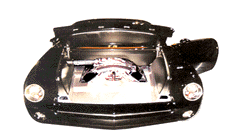 |
Ford ’49 – Many concept cars look to the future, but a few included elements from the past. Out of all the concept cars that hark back to an earlier era, none go farther back than the Ford ’49, which turns back the clock more than a half-century. The ’49 relies on simple shapes and clean body patterns as it takes you on a trip down memory lane. However, its floating center console (at least it appears to be floating) and hard-top door construction make this homage sportier than most vehicles that came out in the few years following World War II. | |
These Concept Cars are featured only on the Internet
| Oldsmobile O4 – The “O4” isn’t just a clever name for this spirited little coupe. The “O” stands for oxygen, which you’ll be getting a lot of while driving this car (Well, not pure oxygen. That would be deadly), and the “4” stands for the number of passengers the car can comfortably hold. The twin Targa tops can be easily removed and stowed behind the rear seat (this is where the oxygen comes in). To avoid the traditional clutter on the dashboard, the O4 offers an “information ring” around the steering wheel column. This liquid crystal display illustrates functions such as speed, engine, rpm, heat and air conditioning settings or music choices. | 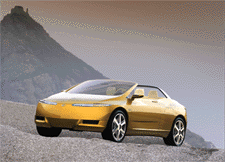 |
|
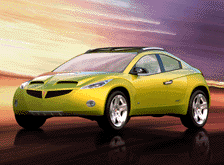 |
Pontiac REV – This bold, athletic sports coupe is designed to take you anywhere you want to go. The REV is capable of handling smooth, twisting pavement to trekking the dirt trail. Between its all-wheel drive and on-the-fly adjustable suspension (the car – except for the wheels, of course – can be raised two inches on rougher terrain), this vehicle has traction on all sorts of surfaces. With the fenders and rocker panels made from tough composite material that extends into the wheel wells, under the hood and to the deck lid, the REV presents a high-tech look of the future. The engine revs by pushing a red “start” button once the driver has identified himself with a coded mini chip-card. A detachable combination GPS-navigation, cell phone and two-way radio can be found in the center console. George Jetson, eat your heart out. | |
| Chevy Borrego – This all-wheel drive vehicle was targeted at the twenty-something consumer who wants a car that offers a comfortable commute during the week, but is still a hot sporty car on the weekends. Inspired by international rally cars, the Borrego has a sporty swept-back look and athletic stance. Inside the dual-cockpit design, you feel a sense of protection from the rough riding. This is accentuated by the hand holds and the gel padding. The car also accommodates two extra passengers with a reconfigurable mid-gate at the rear of the passenger cab. The mid-gate slides rearward and then the full roof, which is stored under the bed of the pickup truck, is snapped into place. The compartment is kept watertight by self-inflating seals. | 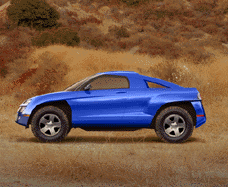 |
|
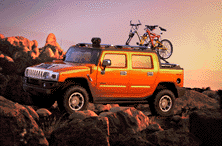 |
Hummer H2 (SUT) – This king of the off-road vehicles is the next evolution of the Hummer brand. This sports utility truck (SUT) is a polished and refined version of its military ancestor, offering a lot more versatility and comfort. The Hummer had GM’s 6.0-liter, Vortec 6000 V8 and is a heavy-duty five-speed automatic with full-time all-wheel drive. Massive towing hooks and receiver hitches are located at both ends of the vehicle, and an optional winch attaches to either the front or the rear to assist in emergency situations. Some of the new technological advancements on the H2 include a roof-mounted 360-degree infrared night vision, GPS navigation, the OnStar system and 110 volt power outlets. | |
| Volvo ACC – The ACC stands for Adventure Concept Car and that’s an accurate description. This SUV has off-road capability, but is at the same time roomy, safe and comfortable. Like the Volvo S60, the ACC has a “cab forward” appearance, which means the driver’s area is at the very front. The gently sloping front lines give the car a muscular effect without making the car look too “macho” or aggressive. Why? Because a large number of SUV buyers are women and Volvo believes they want a feeling of safety and control. This four-seater SUV can also hold a refrigerator, a TV and a world-class audio unit. Sounds like this thing could put limo services out of business. | 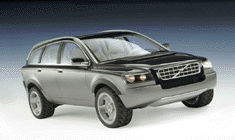 |
|
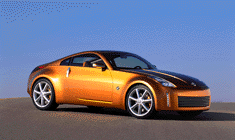 |
Nissan Z – Let me guess. You’d love to have a high performance, cutting edge sports car, for almost nothing. Yeah. Like that’s gonna happen. True, that’s impossible, but you could buy a high performance, cutting edge Nissan Z for under $30,000 when it hits the U.S. market in 2002. This affordable two seater’s design is an international effort between Japan and the United States. The wheel froms are aggressively pushed all the way out to the corners, giving it a wide stance. The body is put together “like an airplane fuselage,” as it seems to be divided into front compartment, center cockpit and rear compartment. The hood, roofline and rear deck are flat. This gives the sense that the center is all one piece. With the Z’s 3.5 liter V6 producing 260 horsepower, the vehicle can go from 0 to 60 mph in less than six seconds. | |
| Audi “Project Steppenwolf” – This may not really be a magic carpet ride, but it’s pretty close. This compact, three-door, four-seater can take you from the quick twists and turns of the highway to the rugged outback. The 3.2-liter V6 engine allows this car to go from 0 to 62 mph in about eight seconds. Its top speed is more than 143 mph. Although some features for “Project Steppenwolf” are unmistakably characteristic of Audi, the flat radiator grille with the four rings, the slim silhouette and the high waistline with the narrow roof, this vehicle has its own unique style. The powerfully contoured bumpers and flared wheel arches show this compact car is ready for anything. | 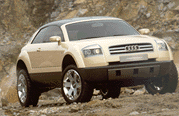 |
|
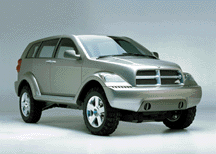 |
Dodge Powerbox – This hybrid concept vehicle can provide the same performance as a V-8 engine, but its fuel efficiency is 60 percent better than most SUVs, and it gives off near-zero emissions. The Powerbox is powered by a V-6 engine, running on clean, compressed natural gas and an electric motor. But don’t assume this vehicle doesn’t have power. According to Richard Schaum, executive vice president of product development and quality: “When you step on the gas pedal, no difference, in the way this vehicle performs from a conventionally powered truck. The large, separate drop fenders are similar to the 1946 Power Wagon and the crosshair grille is typical of a Dodge product. |













